Abstract
A finite algorithm is presented in this study for solving Bilinear programs. This is accomplished by developing a suitable cutting plane which deletes at least a face of a polyhedral set. At an extreme point, a polar cut using negative edge extensions is used. At other points, disjunctive cuts are adopted. Computational experience on test problems in the literature is provided.
Similar content being viewed by others
References
M. Altman, “Bilinear programming”,Bulletin d'Academie Polonaise des Sciences 16(9) (1968) 741–746.
E. Balas, “Intersection cuts—A new type of cutting planes for integer programming”,Operations Research 19 (1971) 19–39.
E. Balas, “Intersection cuts from disjunctive constraints”, Management Science Research Report No. 330, Carnegie-Mellon University (Pittsburg, PA, February 1974).
E. Balas and C.A. Burdet, “Maximizing a convex quadratic function subject to linear constraints”, Management Science Research Report No. 299, Carnegie-Mellon University (Pittsburg, PA, July 1973).
C.A. Burdet, “Polaroids: A new tool in nonconvex and in integer programming”,Naval Research Logistics Quarterly 20 (1973) 13–22.
C.A. Burdet, “On polaroid intersections”, in: P. Hammer and G. Zoutendijk, eds.,Mathematical programming in theory and practice (North-Holland, Amsterdam, 1974).
F. Glover, “Polyhedral convexity cuts and negative edge extensions”,Zeitschrift für Operations Research 18 (1974) 181–186.
F. Glover, “Polyhedral annexation in mixed integer and combinatorial programming”,Mathematical Programming 8 (1975) 161–188.
B. Grünbaum,Convex polytopes (Interscience, New York, 1967).
R.G. Jeroslow, “The principles of cutting plane theory: Part I” (with an addendum), GSIA, Carnegie-Mellon University (Pittsburg, PA, February 1974).
R.G. Jeroslow, “Cutting-plane theory: Disjunctive methods”,Annals of Discrete Mathematics 1 (1977) 293–330.
H. Konno, “Bilinear programming, Parts I and II”, Technical Report No. 71-9 and 71-10, Dept. of Operations Research, Stanford University (Stanford, CA, 1971).
H. Konno, “A cutting plane algorithm for solving bilinear programs”,Mathematical Programming 11 (1976) 14–27.
H. Konno, “Maximization of a convex quadratic function under linear constraints”,Mathematical Programming 11 (1976) 117–127.
A. Majthey and A. Whinston, “Quasi-concave minimization subject to linear constraints”,Discrete Mathematics 9 (1974) 35–59.
G. Owen, “Cutting planes for programs with disjunctive constraints”,Optimization Theory and its Applications 11 (1973) 29–55.
H.D. Sherali and C.M. Shetty, “Deep cuts in disjunctive programming”, Paper presented at the Joint National ORSA/TIMS Meeting, New Orleans, LA (May 1979).
C.M. Shetty and S. Selim, “Stochastic location—allocation problems and bi-convex programming”, Presented at the ORSA/TIMS Meeting, New York, (May 1978).
C.M. Shetty and H.D. Sherali, “Rectilinear distance location—allocation problem: A simplex based algorithm”,Proc. of the Internat. Symp. on Extremal Methods and Systems Analysis, Lecture Notes in Economics and Math. Systems (Springer, 1980).
R.M. Soland, “Optimal facility location with concave costs”,Operations Research 22 (1974) 373–382.
H. Vaish, “Nonconvex programming with applications to production and location problems”, Unpublished Ph.D. Dissertation, Georgia Institute of Technology (Atlanta, GA, 1974).
H. Vaish and C.M. Shetty, “A cutting plane algorithm for the bilinear programming problem”,Naval Research Logistics Quarterly 24 (1977) 83–94.
H. Vaish and C.M. Shetty, “The bilinear programming problem”,Naval Research Logistics Quarterly 23 (1976) 303–309.
P. Zwart, “Nonlinear programming: counter examples to two global optimization algorithms”,Operations Research 21 (1973) 1260–1266.
P. Zwart, “Computational aspects of the use of cutting planes in global optimization”, in:Proceedings of the 1971 Annual Conference of the ACM (ACM, 1971) pp. 457–465.
P. Zwart, “Global maximization of a convex function with linear inequality constraints”,Operations Research 22(3) (1976) 602–609.
Author information
Authors and Affiliations
Additional information
This paper is based upon work supported by the National Science Foundation under Grant No. ENG-77-23683.
Rights and permissions
About this article
Cite this article
Sherali, H.D., Shetty, C.M. A finitely convergent algorithm for bilinear programming problems using polar cuts and disjunctive face cuts. Mathematical Programming 19, 14–31 (1980). https://doi.org/10.1007/BF01581626
Received:
Revised:
Issue Date:
DOI: https://doi.org/10.1007/BF01581626




